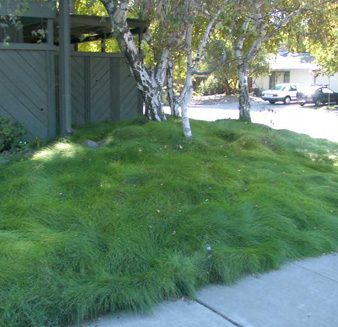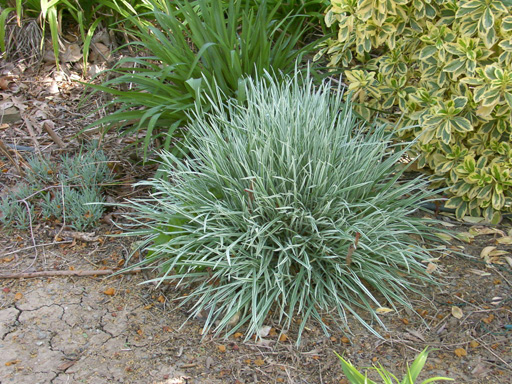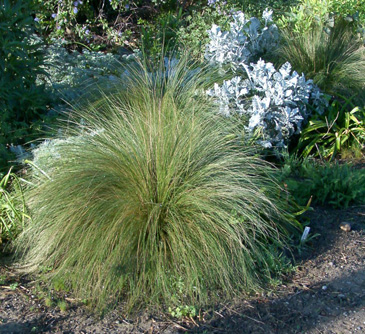When I was a teenager and showed an interest in gardening, my parents gave me a part of the yard to call my own, to do with as I pleased. The very first thing I did was stop mowing the lawn and let the grasses grow to their natural heights. The bluegrass grew a few inches tall and spread out, taking on the look of a soft shaggy carpet.
But a few plants of what my father called "Kentucky clump grass" (to this day I have no idea what grass it was; there is no plant by that name) formed dramatic clumps, growing to 18" tall and then sending up striking spikes of flowers. My father was horrified, of course, at the unkempt lawn. It bothered him far more than my unkempt hair (this was the 70's, kids). Little did he know that I was ahead of my time, as usual.

Within the last few years ornamental grasses have become all the rage. Dozens of species and selected varieties have been introduced, and nearly every wholesaler now grows at least a few types. What they provide in the landscape is drama; designers call them "accent plants."
Strong vertical lines, colors ranging from blue through grey, golden- and white-striped, spotted, and some varieties with purple-red foliage and flowers--there is quite a range of textures and colors.. Most have flowers which can be described as "interesting," but a few have showy plumes that are what fancy horticulture writers would call "worthy."
But my father's objection can be valid: grasses can look weedy, so know the growth habits and place them carefully in the landscape. If they spread by rhizomes they may cover large areas and even become invasive. Similarly, some reseed.
Some of the worst invasive plants introduced into California have been grasses that were introduced intentionally: dwarf Pampas grass (Cortaderia jubata), Giant reed (Arundo donax), Bermudagrass and Kikuyugrass (looks like bermudagrass on steroids, and has spread freely in coastal Southern California).
Most are deciduous, meaning they turn brown in the fall and the tops die back. While this can look attractive against a snowy field, here they just look kind of battered and forlorn (the majority can be cut back severely without any harm).

So why grow them? The larger clumping types can be a stately addition to the summer garden. Spreading types soften the lines of a formal border. Grasses are incredibly easy to grow: most require only average water, some are very drought tolerant, and all require at most one annual pruning (and there's no special skill needed--you just mow them off). Lower types can be used as informal lawn substitutes.
Grasses are excellent container plants, especially combined with soft grey foliage such as Artemisia 'Silver Mound', or trailing flowering plants such as Verbena 'Tapiens'. Most prefer full sun, but Japanese forest grass (Hakonechloa) prefers shade, and there are grass-like shade plants that give similar effect: Turf lily (Liriope) and Mondo grass (Ophiopogon).
The most common mistake I see in the landscape is crowding of the larger types. There should be open space to show off the arching habit and the bloom spikes. Using too many types in close quarters leads to a busy look--kind of like an overgrown meadow. Mix them with summer and fall blooming perennials, which complement the growth and bloom cycle.
So with myriad to choose from, where to begin? I sort them by spreading habit and size: spreading and clumping; small (< 18"), medium(to 3'), and big.
Spreading grasses. are used as ground covers. Korean grass (Zoysia) makes an interestingly lumpy addition to oriental-style gardens. Blue (aka grey) fescue (Festuca ovina glauca) is a clumper, but planted on 1' centers it makes a great edging around paths or along borders.
Blue oatgrass is a medium height spreader with wide blue-grey leaf-blades; it has an open habit, making a great ground cover under tall, open shrubs. The Japanese forest grass spreads slowly in woodland gardens, and the golden variegated leaves light up the shady areas.
Clumping grasses
The blue fescue can also make an attractive pattern of clumps when individual plants are spread 2 - 3' apart, and then mixed with taller plants with similar growth habit such as daylilies or Agapanthus.
Mexican feather grass (Stipa tenuissima) is one of my favorites, with soft green needle-like foliage and a mounding growth habit. Very graceful and refined looking, it moves softly in the breeze. It also reseeds happily, so be forewarned.

Medium clumpers are best represented by the Pennisetums, especially P. setaceum 'Cupreum'--the purple Fountain grass. The purple spreading leaves and plumes make it the showiest grass. It is marginally hardy here, so you'll need to replace it after cold winters. This Pennisetum is sterile, so it will not reseed. Other species have become somewhat invasive, especially in Southern California.
Taller clumpers are the ones to use carefully and sparingly. The large Pampas grass (Cortaderia sellowiana) has been widely planted for years; this is the 8'+ clump with 10' white plumes that you see around farmhouses. And that's the place for it; the blooms are messy, the plant is way too big for most yards, and the leaves have razor sharp edges. But in the right place it is very showy, and it doesn't reseed (unlike C. jubata).
Miscanthus has become the most popular genus of large clumpers, with dozens of types. Leaves grow upright, then arch over, and the plumes are carried above the foliage. Some have interesting stripes or spots. Most are deciduous, so you just whack them to the ground in the fall or spring. Miscanthus transmorrisonense is evergreen.
Stipa gigantea grows to 3' or more, and the showy blooms stand up to 6'. A single plant surrounded by low, spreading grasses, or a soft green ground cover such as chamomile, makes a real statement.
Just keep in mind that the spot will be bare in the winter; plant bulbs that bloom in the spring around it to fill the void. In fact, spring bulbs make great companions with the grasses, as their growth and bloom cycles are just opposite of the grasses'.
Some notes on finding and planting grasses:
Availability is best in the summer, as the growers need warm weather to get the plants out of winter dormancy and attractive enough for retail sales.
They are very root bound when you buy them, as grasses have fast-growing root systems (some growers are doing them in #2 and #5 pots for this reason). Just cut and spread out the bound, circling roots when you plant them; water carefully--every day or so--for the first couple weeks, and then gradually adjust to your normal watering schedule.
After a couple of years of growing dozens of varieties, most growers are thinning their production lists to the best sellers and those with good container appearance. Unusual types may be available by special order or through mail order nurseries.
Natural meadow? Or bad hair day? Grasses can be a matter of taste, but used and selected carefully they can provide contrast, color, and interest. Good luck persuading Dad!
